Copenhagen Cinerama Introduction |
Read more at in70mm.com The 70mm Newsletter |
| Written by: Randy Gitsch, Producer Cinerama Restoration Team | Date: 07.12.2018 |
“Windjammer: The Voyage of the Christian Radich”
|
|
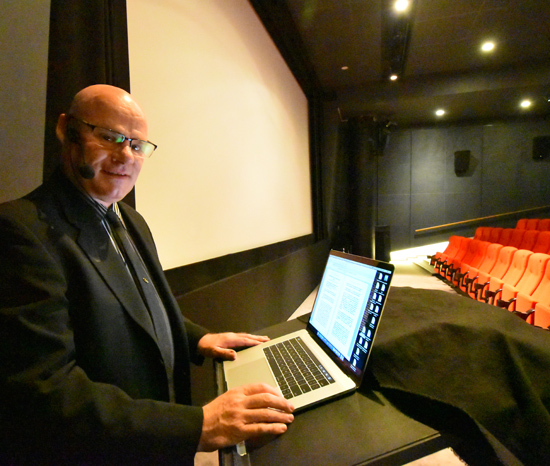 "Cinerama films are very much a time capsule. It's not just real widescreen drama, its actually real people the way
they really talked, thought and acted at that time. I think it is a
fascinating library of motion picture history." Randy Gitsch "Cinerama films are very much a time capsule. It's not just real widescreen drama, its actually real people the way
they really talked, thought and acted at that time. I think it is a
fascinating library of motion picture history." Randy Gitsch"Hej" igen gamle venner. "Velkommen" gester! My name is Randy Gitsch. I’m here with my film restoration-production partner Dave Strohmaier and we’re delighted to be here in Copenhagen once again. You’re all tonight witnessing what is an amazing rebirth in the life of the 1958 Cinemiracle, 3-panel motion picture release, “WINDJAMMER: THE VOYAGE OF THE CHRISTIAN RADICH”. By the 1990’s no one knew of the whereabouts of a good print of this picture, only one faded print was thought to still exist, and that was in Australia. However, in late 1996, a second print was discovered in a theater in Essen, Germany by theater owner Udo Heimansburg, and once found, it created an immediate buzz. Word made it to Thomas Hauerslev, the editor of The 70mm Association Newsletter, and later the webmaster of in70mm.com-based right here in Copenhagen, who shared the news with Jan Olsen-of the Norwegian Film Institute and Harald Tusberg-one of the stars of “WINDJAMMER”. Harald, by then a loved television personality in Norway pledged then that it was his wish to see this print shown in the Colosseum Kino in Oslo, where it had originally premiered and that he was prepared to intervene to see that happen. But once the print was viewed and its’ dire, badly faded state was noted, the notion of any paid public screening of it had to be dashed. As Thomas Hauerslev is in our audience today, I think he deserves our applause for that noble, wishful involvement. Dave and I first saw this picture, in 3-panel, on March 8, 2008. And as I mentioned that print we viewed was badly faded and dubbed in German. With the first funds made available to us through the preservation consciousness-raising success of our documentary “CINERAMA ADVENTURE”, we shortly thereafter performed modest digital restorations on the first Cinerama release, “THIS IS CINERAMA” and on its’ original Cinemiracle competitor, “WINDJAMMER”. We’ve subsequently re-mastered all eight (8) of the 3-panel Cinerama-release travelogues. We were not satisfied with our first “WINDJAMMER” results, especially after comparing them to later re-masters made directly from original camera elements, so we sought out the means to revisit “THIS IS CINERAMA” and “WINDJAMMER”, to more closely perfect new digital versions. We screened our new version beginning in January at the Museum of Modern Art in New York City, then before audiences at the EYE Filmmuseum in Amsterdam, and at the Cinematheque Francaise in Paris in March, to widespread approval. Tonight, we’ll show you our new “WINDJAMMER”, and I can promise…you’ll be at the edge of your seat watching the detail, clarity, color match and often eradicated divide lines, that will pull you forward and make you feel like you’re in the picture. And through the application of our trademarked Curved Screen Simulation “Smilebox”®, it will be fully immersive. The best news…Flicker Alley has just 2 weeks ago released both our newly revisited versions of “THIS IS CINERAMA” and “WINDJAMMER” on stand alone Blu-ray. So now ‘WINDJAMMER” looks as good as it did in 1958, right in your home. But tonight, it will look that good right here. I want to shout out that our Swedish friend, Mr. Anders Olsson, who’s in our audience, has generously created the Danish language subtitles for tonight’s show. So please…I’ve already taken my see sickness pills, so let’s fasten our life vests, and get ready to sing sea shanty’s. But before we sail, let’s hear from Dave who can tell us what’s made this version excel. Dave… [DAVE SPEAKS about the restoration] |
More in 70mm reading: Gallery: Smell-O-Vision & CineMiracle at the Cinemateket, Copenhagen The Cinerama Archaeologists Louis de Rochemont's "Windjammer" produced in Cinemiracle in70mm.com's Cinerama page Remastering the CINERAMA Library Internet link: |
 "I
think the biggest pleasure is showing it to people and probably, in my case,
it's when you have a big crowd watching it and you can sense that the
audience is "into it"". Dave Strohmaier "I
think the biggest pleasure is showing it to people and probably, in my case,
it's when you have a big crowd watching it and you can sense that the
audience is "into it"". Dave Strohmaierfilm Intro [as read] [7:00] Thanks Dave. When the voyage in this film began, the star ship, the Christian Radich, was only 19 years old, about as old as most of it’s Norwegian sailor-trainee crew. This graceful ship is a steel-hulled “square-rigger”, with three full-rigged masts, the tallest of which, the “foremast”, towers 39 meters feet above the waterline. Its width, or beam, is about 11 meters, and it’s 62 meters long. The Christian Radich was always a sailor-training vessel, and did so, excepting an interruption during the War, when it was sunk at the docks in Flensburg. After the war, the ship was refloated and repaired. It resumed sail training again in 1947. On Saturday, December 8, 1956, it left the port of Oslo, for the start of its’ 17,500 mile trans-Atlantic roundtrip. With it’s 69-year-old Captain, Yngvar Kjelstrup in command-who was making this voyage his last before retiring, it had a crew of 5 Officers, 11 Petty Officers and Able Seamen, and 45 Cadets, ranging in age from 14 to 22 onboard. And it took along a canine mascot, a little Norwegian Elkhound named Stumpf. The dramatic surge of Windjammer’s epic story, and the scope of its Cinemiracle cinematic process, almost lets you forget that every time you see the Christian Radich on a distant horizon, in a majestic profile, or magnificently approaching you…you’re standing on another ship. This film required the use of a floating “camera car”, if you will. All you’ll ever see of it will be its’ frothy wake, however its existence actually changed the narrative of the picture, and allowed for a more dynamic production. For example, this other ship arrived in Funchal, Madeira on Dec. 31, 1956 in order to film fireworks that night celebrating the Feast of St. Silvester, however, the Christian Radich and crew didn’t port there until over a week later. The Christian Radich will make a stop in Manhattan on it’s trans-Atlantic crossing, and while there, none other than the famed, true crime “dark photographer” and photojournalist Arthur “Weegie” Fellig will helm the 3-lensed Cinemiracle camera. Weegie’s special camerawork will be anything but standard, in a film already in a non-standard format. He’ll use prisms and kaleidoscopic lenses for example. We’ll also see a bit of Denmark in “WINDJAMMER”. Look out for Tivoli Gardens, the Tivoli Boys Royal Guard and Band, the Town Hall Square and the even the ‘Tattoo Ole’ shop in Nyhavn, which is still there. Among the noteworthy encounters along the voyage, certainly noteworthy to the sailor trainees, the Christian Radich was to pass alongside several other sailor training vessels flying a variety of national flags, like the Flying Clipper, Eagle, Danmark and the Sir-landet. On Sunday, Jan. 17, 1957, the Christian Radich met up with the German school ship Pamir. Pamir, with its’ novice Captain, Johannes Diebitsch, crew of 34 officers and men, and 52 young cadets, was bound for Montivideo, Uruguay. This encounter was pure happenstance and the Cinemiracle cameras caught it entirely from onboard the Christian Radich. The two ships actually sailed around and past each other. Pamir was a much older vessel having first sailed on July 29, 1905. It too was steel-hulled but was four-masted, and of a particular longer design called a barque. The Pamir’s beam was 14 meters, and it was 114 meters long…almost twice as long as the Christian Radich. This encounter takes up less than 2˝ minutes on screen, and after it, the Pamir was doomed. After dropping its load in Uruguay, it was to sail on to Buenos Aires and pick up 3,780 tons of barley for its’ return trip to Hamburg…and that it did. However, in the midst of its return voyage across the Atlantic to Germany, on Saturday, Sept. 21, 1957, it sailed into Hurricane Carrie without warning and capsized. The result - was that of a crew of 86, only 6 survived. The sinking, occurring while the motion picture was in post-production, became a German national tragedy…and a shocking worldwide loss. |
|
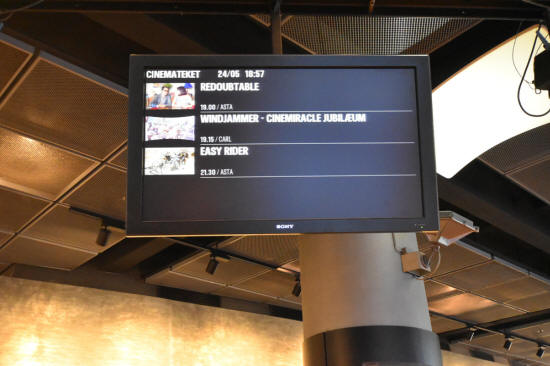 And here, the genius of the film’s producer Louis de Rochemont and his son,
Louis III, its’ director, took charge. As the veteran helmer of - and Academy
Award winner for - the acclaimed newsreel “THE MARCH OF TIME”, which ran from
1935 through 1951, de Rochemont and son knew how to spin the dramatic potential
from real-life events. The loss of Pamir became a dramatized dénouement for the
motion picture, realistically expressing the pro & con thought on the future of
all sailing school ships in the aftermath of the sinking. And here, the genius of the film’s producer Louis de Rochemont and his son,
Louis III, its’ director, took charge. As the veteran helmer of - and Academy
Award winner for - the acclaimed newsreel “THE MARCH OF TIME”, which ran from
1935 through 1951, de Rochemont and son knew how to spin the dramatic potential
from real-life events. The loss of Pamir became a dramatized dénouement for the
motion picture, realistically expressing the pro & con thought on the future of
all sailing school ships in the aftermath of the sinking.I had the very special opportunity recently of visiting Lubeck, Germany where I screened this film. And there, I payed my respects to the Pamir at the Memorial for Civilian Shipping in old city at St. Jacob’s church. Here is displayed one of the recovered lifeboats from the site of the sinking. It was a moving experience to see that small, battered boat and the names of all its lost sailor trainees and crewmen engraved in stones on the floor around it. Today, as many of you well know, the Christian Radich still sails. It is owned by the Christian Radich Sail Training Foundation, and is home berthed right in Oslo. It still cruises the fjords, and well beyond…and can also be rented in certain months for private events. And as I’ve sailed on the ship just 3 years ago, I can attest, it’s in immaculate condition. Ever since Dave and I began our work on “WINDJAMMER” it’s been most interesting for me to meet surviving crewmen from the Christian Radich. When we screened this picture in Oslo the first time, in 2010, and met the stars of the film, Assistant Bosun and actor/singer Lasse Kolstad introduced Dave, Dave’s wife, Carin-Anne and I to his wife, a strikingly beautiful woman and former actress. And Lasse explained that her name was Barbra Karine Christensen, and that although the nickname she most-often used for her first name was “Bab”, the nickname for her middle moniker was “Kari”, and in fact, this was the one and the same Kari that he was singing about when he sings the memorable “Kari Waits For Me” in the film. In all truthfulness, Lasse and Bab did marry during the coarse of the film, in one of the ship’s ports-of-call, Miami. So…Kari was waiting for him. And together they remained married until Lasse’s passing at the age of 90, on Jan. 14, 2012. And sailor-trainee Cadet #2 and actor, Kaare Terland told us that the ship’s four-legged mascot Stumpf, who demonstrates admiral sea legs on his ocean journey, actually bailed ship as soon as they’d docked, at one of their stops. Production, however, was fortunate in finding a nearly identical replacement before they set sail again. So there are 2 Stumpfs. The filmmakers actually wove into their story a strand about the dog running away…although in a convenient fiction they get the same dog back on the boat. “WINDJAMMER” premiered at Grauman’s Chinese Theater, in Hollywood, on April 8, 1958, advertised with the byline, “The day you’ll never forget is the day you’ll see Windjammer”. It premiered right here in Denmark at the Arhus Hallen on December 1, 1958, where it ran for 21 weeks. The picture received very, very good reviews and beat Cinerama in the showing of 3-strip films in Denmark. One of the best reviews the picture got came from film director David Lean. Shortly before "Windjammer" was actually completed, the English director contacted the President of Louis de Rochemont Associates, Borden Mace, at their Bronx-based screening room, asking if he might be able to see Cinemiracle projected. The answer was affirmative, and a short time later Mace met Lean there and asked his staff to screen several scenes including the Madeira sequence and the just-completed scene in which a submarine, with a Cinemiracle camera mounted on it, surfaces through a hail of bubbles to reveal crashing waves and the majestic Christian Radich at that moment sailing closer. Lean asked to see the latter a second time. Later that day, sharing the taxi ride on the way back to Manhattan, Lean remarked to Mace, 'That submarine scene emerging from the ocean waters is the single most impressive shot I have ever seen on a motion picture screen.' One last word. This is a road show with overture and a 15 minute intermission. And now, let’s pull up anchor and embark…on this Cinemiracle Adventure. |
|
“THE LAST DAYS OF CINERAMA” DOCUMENTARY INTRO
|
|
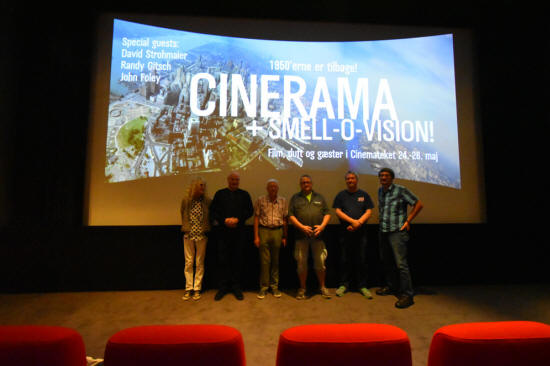 “THE LAST DAYS OF CINERAMA” is a documentary short by Mike Celestino and Robert
Garren following the shooting of our short promotional film, “IN THE PICTURE” as
it was being shot around Los Angeles. “THE LAST DAYS OF CINERAMA” is a documentary short by Mike Celestino and Robert
Garren following the shooting of our short promotional film, “IN THE PICTURE” as
it was being shot around Los Angeles. Both Celestino and Garren were graduates of the University of Southern California Film School. And in 2010, they’d made a short comedy film called “MIKE CELESTINO’S POTENTIALLY-AMUSING VIGNETTES”. Together this duo co-wrote, then co-produced, and co-directed that film, so they knew they could work well together. By the time they’d graduated, Mike Celestino had been working for a few years as a projectionist at the ArcLight Multi-plex and its’ world-famous Cinerama Dome Theater in Hollywood, California. Mike had heard from John Sittig, at the time the Director of Sight and Sound for the ArcLight that a film was actually going to be made in Cinerama, albeit a short subject in three-panel, 35mm film using a refurbished Cinerama camera. When John told Mike that this film would be the first triptych shot in Cinerama in 50 years, Mike immediately contacted his friend Rob and they decided then and there to film the making of this Cinerama short. As film students and Los Angelino-based filmmakers, they both knew well of the Cinerama Dome Theater’s grandeur and the allure of the Cinerama widescreen process. John Sittig introduced Mike and Rob to Dave Strohmaier, who gave them a copy of our documentary on Cinerama, “CINERAMA ADVENTURE”, to put in proper perspective what was about to happen. Dave told them that the name of the Cinerama production was going to be “IN THE PICTURE”, explaining how that phrase was used by Cinerama in it’s 1952-1966 heyday to convey its’ immersive participatory quality. And thereafter what began to really sink in, and become overwhelmingly apparent to Mike and Rob before they even started to make this film was the cinema history that was going to being made utilizing this now moth-balled, but at-one-time, state-of-the-art technology. And they were awed by the enthusiasm of the crew making it, as they too knew all-too-well the history they were making. As Rob Garren told me recently, “We were glad we captured their excitement.” “THE LAST DAYS OF CINERAMA” premiered appropriately at the Cinerama Dome on its’ big 32 foot-high by 86 foot-wide screen, on Sept. 28, 2012 during the memorable Cinerama 60th Anniversary Film Festival held there, where you can imagine it was very popular. They also entered this film in several film festivals and won the Audience Award for “Best Documentary Short” at the Dam Short Film Festival in (wait for it!) Boulder City, Nevada, the home of Hoover Dam. Celestino and Garren have gone on to work on other films and to again work together. In 2014 they created the feature-length documentary called “THAT’S NOT FUNNY”, about taboo and controversial subjects in comedy. Putting Cinerama in perspective, meant of course that unlike ‘IN THE PICTURE”, they had the burden of telling of Cinerama’s historical arc, and so they did so, asking questions of their interviewees celebrating both the revival and acknowledging the demise of the first, major wide-screen process. So, let’s take a look at “THE LAST DAYS OF CINERAMA”. |
|
CINEMIRACLE’S “A TALE OF OLD WHIFF” INTRO
|
|
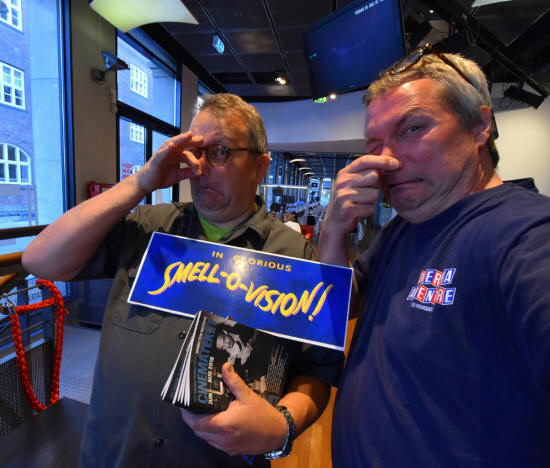 Original Film Studio collections and archives, the world over, each have a
sought Holy Grail, a singular missing film asset that stands out among all
others. Original Film Studio collections and archives, the world over, each have a
sought Holy Grail, a singular missing film asset that stands out among all
others.For Metro-Goldwyn-Mayer that’s Lon Chaney’s horrific 1927 “LONDON AFTER MIDNIGHT”. For Warner Brothers, the notorious pre-puritanical Hayes Code, “CONVENTION CITY” of 1933. And here in Denmark, might that lost film be the complete “ A VICTIM OF THE MORMONS” by August Blom, from 1911? For Cinerama Inc. it was, until June 30, 2016, the one reel animated cartoon, “A TALE OF OLD WHIFF”. This cartoon accompanied Mike Todd Jr.’s feature film, “SCENT OF MYSTERY” in its’ original January 1960 theatrical engagements. And just like that feature, presented right here in Copenhagen in 2015, it was presented in Smell-O-Vision. The cartoon featured twelve unique scents of its’ own, none of which were used in the feature. And it was, thee, first, cartoon short to screen in 70mm. “A TALE OF OLD WHIFF” stars “Whiff”, a bloodhound put to work by an intrepid detective voiced by Bert Lahr, our previously-favorite cowardly lion, here doing some investigative work searching for a museum’s missing dinosaur bone worth $100,000.00. One small problem, Whiff has anosmia. He’s lost his sense of smell…he can’t smell anything…but we, the audience do…at least in 1960 in Smell-O-Vision, we did. Animation is by the talented John Hubley, the creator of Mr. Magoo. So there’s distinctly a bit of a UPA Studios animation look here. Nathan Zucker produced, Alan Zaslove directed-taking over that task from Hubley, and Leo Salkin wrote the story. I’m telling you these cartoon credits, because just like those for the feature, “SCENT OF MYSTERY”, they didn’t originally appear on the screen. In 1960 they were all in your original souvenir printed program. Dave has now responsibly tagged them onto the tail of this re-working. When Dave Strohmaier and I re-mastered “HOLIDAY IN SPAIN”, the de-scented derivative from “SCENT OF MYSTERY”, we both wanted badly to find this cartoon. Dave searched can labels in what was then the Cinerama vault and found nothing. I did a call out within the Association of Moving Image Archivists, of which I’m a founding member and I posted a plea on Thomas Hauerslev’s authoritative in70mm.com website, based right here in Copenhagen. “Thanks”, again Thomas. I contacted Scott MacQueen, Head of Preservation at University of California at Los Angeles and then Emily Hubley, daughter of the late animator, and they could find nothing. I also contacted Jerry Beck at ASIFA, the International Animated Film Association. That led to Dave trekking to another warehouse miles away and several weeks later, with Jerry Beck, to go through pallets of donated materials from the film’s animation studio, Format Films. But it resulted in no Holy Grail discovery. Only after the entire Cinerama film collection was moved and deposited with the Academy of Motion Picture Arts and Sciences in Hollywood, was each and every can meticulously gone through. And there on June 30, archivist Andrew Bradburn, found a small roll of acetate, in a rusty 70mm shipping case with only the hard-to-read handwritten scribble, “C A R T O O N” on a tiny label. And that was our “Whiff”. I’m sure the omnipresent vinegar syndrome was by then providing a new scent to the experience. Dave has now supervised a digital telecine in which the color has again been brought out of that old, faded pink print, and here is the long lost tale…”A TALE OF OLD WHIFF”. Alas it is no longer in Smell-O-Vision, but let me tell you what you the viewer, and not Old Whiff, would have smelled in 1960. Those twelve scents then included; hot dogs, mustard, soap, chocolate candies, rain, a violet, pine trees, a field of flowers, a field of clover, soup, a wreath of flowers, and perhaps most importantly, the concocted smell of “bone”, that’s right “bone”. It appeared in 3 places…and provided a narrative clue. By the way, this cartoon was presented after the Smell-O-Vison feature “Scent of Mystery”, it didn’t precede it. And so you won’t see an opening title card per se, but what you will see first will make total sense. Now before we enjoy this re-discovered 1960 lark, now premiering in Denmark for the very first time, the truly rare, “A Tale of Old Whiff”, let’s hear from Dave about its’ restoration |
|
“HOW THE WEST WAS WON” INTRO
|
|
 “HOW THE WEST WAS WON” has been seen by millions around the globe, but not
always in its unique 3-panel version. That’s because this motion picture, one of
two co-produced by Cinerama, Inc. and Metro-Goldwyn-Mayer, also had a “flat”
version which screened in many, many more conventional, non-Cinerama theaters,
but with mono sound and slightly cropped, and was eventually broadcast on
television, although there it was severely cropped. You are seeing today what
unquestionably became the most revered version of the picture, the one seen in
Cinerama theaters, the whole picture in its intended panoramic, multi-track
stereo splendor. “HOW THE WEST WAS WON” has been seen by millions around the globe, but not
always in its unique 3-panel version. That’s because this motion picture, one of
two co-produced by Cinerama, Inc. and Metro-Goldwyn-Mayer, also had a “flat”
version which screened in many, many more conventional, non-Cinerama theaters,
but with mono sound and slightly cropped, and was eventually broadcast on
television, although there it was severely cropped. You are seeing today what
unquestionably became the most revered version of the picture, the one seen in
Cinerama theaters, the whole picture in its intended panoramic, multi-track
stereo splendor. This picture was huge in every way. Not only did it boast an awesome cast of 14 top-notch actors, but even its’ supporting cast is noteworthy. Some of you may leave the theater today admiring the performance or personality of Thelma Ritter, or Andy Devine, for they were unique and beloved character actors from an era when such a thing existed in Hollywood motion picture casting. And “HOW THE WEST WAS WON” had three top directors, Henry Hathaway, John Ford and George Marshall, each already firmly respected as talented, innovative and artful. It was based on tried and true literary material. It had appeared as a multi-part, widely read and well-received series of stories by James Webb, that had appeared in Life magazine in 1959, and were still fresh in the minds of the movie-going public. And several of its’ memorable songs had just appeared on a 2-album release of the same name sung by Rosemary Clooney, Bing Crosby and others. ”HOW THE WEST WAS WON” proved to be a critical success; earning Academy Award nominations for Best Picture, Best Original Score, Best Art Direction/Set Decoration (in Color); Best Color Cinematography, and Best Costume Design (in Color). And it won Oscars for Best Film Editing, Best Sound and Best Story & Screenplay. It was also named one of the Best Films of 1963 by the National Board of Review in the U.S. It premiered here in Denmark on December 26, 1962, almost 2 months before it opened in the U.S.. Was anyone here today at the Kinopalaeet for that premiere? It played there for 26 weeks, that’s a half a year in Copenhagen. Tickets for it’s more than 1,100 seats cost 4, 6, 10, 11 or 15 Kroner. You entered at Gammel Konge Vej. Unfortunately that showplace theater was demolished in 2001. “HOW THE WEST WAS WON” was successful financially…HUGELY successful. It became the highest-grossing motion picture of the year, just as “THIS IS CINERAMA” had done 10 years earlier. But the seeds of Cinerama’s demise lay in “HOW THE WEST WAS WON’s” success. Because it made so much money, its’ production difficulties were tempered and its’ huge negative cost was surmounted. However, it grandly elevated expectations for its’ sister MGM/Cinerama dramatic co-production, ‘THE WONDERFUL WORLD OF THE BROTHERS GRIMM”. And “GRIMM” was not a huge success. Don’t get me wrong, it was well received and it made back it’s cost, but it was not a juggernaut as “WEST” had been. |
|
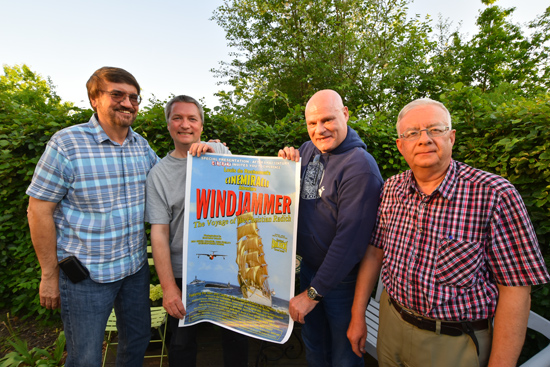 Cinerama
crew gathering in Copenhagen. Dave, Thomas, Randy and Anders.
Picture by Charlotte Hauerslev Cinerama
crew gathering in Copenhagen. Dave, Thomas, Randy and Anders.
Picture by Charlotte HauerslevThe President of Cinerama had put up 13.5 million dollars of Cinerama money towards the production cost of the new pictures with MGM, but after the runs of “HOW THE WEST WAS WON” and the “THE WONDERFUL WORLD OF THE BROTHERS GRIMM”, Cinerama Inc. was bleeding money. Its’ simultaneous-to-production embark on a massive worldwide theater expansion had been costly. Despite “WEST’s” achievement as a blockbuster-“GRIMM” had not been as profitable-it did make only 14 million. ”WEST” had cost 15 million to make, but made back 50 million. In some Cinerama venues, the less popular “GRIMM” had to pulled and replaced by one of the older Cinerama travelogues. This all came back to roost at Cinerama forcing it to take a long hard look at its’ early 1950’s business model, which now in the 1960’s was no longer as profitable. Let’s face it, three times as much film cost three times as much to ship, and now at 1960’s rates and around the world. And because its complexity required an experienced skill set, its’ theaters still required the employ of multiple senior projectionists. Now in “HOW THE WEST WAS WON”, like many pictures, there had been some stock shots, for example-of Mexican soldiers from John Wayne’s “THE ALAMO” shot in Todd-AO. And there had been some process shots-rear-projection for example, when stars were flailing about on a sinking raft in the safety of a studio tank, rather than actually drowning in a raging river, and those had been shot in Ultra Panavision. Some of you today will notice those shots and think they stand out like a sore thumb when compared to the balance of the picture, in Cinerama’s 3-camera capture. But in the height of drama and adventure-“in the moment” of the movie, some people didn’t notice the difference. At least, when you realized how much cheaper those shots had been to create some, in charge of production didn’t notice, and so Cinerama’s President made the decision to save money by shooting any future Cinerama picture in single-lens Ultra Panavision. Cinerama would be retained as an exhibition format only, on the curved screen with road show luxury. Today’s presentation IS a road show, so it will feature an overture and intermission. Now a certain Brit, a Mr. Muncher, installed the Cinerama equipment in the Kinopalaeet and then announced that the 7th row from the screen was the “sweet spot”, …so word may have gotten out then. I suggest that some of you in the back move up today to get the best Cinerama effect. I want to shout out to our friend, Mr. Anders Olsson-in the audience today has created the Danish language sub-titles for today’s show. “Thank You, for that”, Anders. And now that Dave and I are heading momentarily on to Oslo for a Cinerama show there tomorrow, I want to thank our Cinemateket host, Mr. Rasmus Brendstrup and that staff here. We’ve enjoyed each one of our Copenhagen audiences. |
|
| Go: back - top - back issues - news index Updated 22-01-25 |
